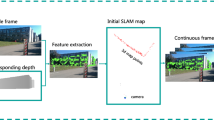Abstract
This paper presents a novel approach to the real-time SLAM problem that works in unstructured indoor environment with a single forward viewing camera. Most existing visual SLAM extract features from the environment, associate them in different images and produce a feature map as a result. However, we estimate the distances between the robot and the obstacles by applying a visual sonar ranging technique to the image and then associate this range data through the Iterative Closest Point (ICP) algorithm and finally produce a grid map. Moreover, we construct a pseudo-dense scan (PDS) which is essentially a temporal accumulation of data, emulating a dense omni-directional sensing of the visual sonar readings based on odometry readings in order to overcome the sparseness of the visual sonar and then associate this scan with the previous one. Moreover, we further correct the slight trajectory error incurred in the PDS construction step to obtain a much more refined map using Sequential Quadratic Programming (SQP) which is a well-known optimization scheme. Experimental results show that our method can obtain an accurate grid map using a single camera alone without the need for more expensive.
Similar content being viewed by others
References
Burguera, A., Oliver, G., Tardos, J.D.: Robust scan matching localization using ultrasonic range finders. Paper presented at the International Conference on Intelligent Robots and Systems, Alberta Canada, 2–6 August 2005
Burguera, A., Gonzalez, Y., Oliver, G.: A solution for integrating map building and self localization strategies in mobile robotics. Int. J. Intell. Syst. 20(5), 499–521 (2005)
Choi, Y., Oh, S.: Visual sonar based localization using particle attraction and scattering, International Conference on Mechatronics and Automation, Niagara Falls, Ontrario, Canada, (2005)
Davison, J.: Real-time simultaneous localization and mapping with a single camera. Paper presented at the International Conference on Computer Vision, Nice, France, (2003)
Dissanayake, G., Newman, P., Clark, S., Durrant-Whyte, H.F. and Csorba, M.: A solution to the simultaneous localization and map building (SLAM) problem. IEEE Transaction on Robotics and Automation (2001)
Groβmann, A., Poli, R.: Robust mobile robot localization from sparse and noisy proximity readings using Hough transform and probability grids. J. Robot. Auton. Syst. 37(1), 1–18 (2001)
Gutmann, J.S., Schlegel, C.: AMOS: Comparison of scan matching approaches for self-localization in indoor environments. Euromicro Workshop in Advanced Mobile Robotics (1996)
Jung, W., Lee, K.: CV-SLAM: A new ceiling vision-based SLAM technique. Paper presented at the International Conference on Intelligent Robots and Systems (2005)
Kim, G., Kim, J., Hong, K.: Vision-based simultaneous localization and mapping with two cameras. Paper presented at the International Conference on Intelligent Robots and Systems (2005)
Krose, B., Vlassis, N., Bunschoiten, R., Motomura, Y.: A probabilistic model for appearance-based robot localization. Image Vis. Comput. 6(19), 381–391 (2001)
Lenseir, S., Veloso, M.: Visual sonar: fast obstacle avoidance using monocular vision. Paper presented at the International Conference on Intelligent Robots and Systems, October (2003)
Lowe, D.: Distinctive image features from scale-invariant keypoints. Int. J. Comput. Vis. 60(2), 91–110 (2004)
Lu, F., Milios, E.: Robot pose estimation in unknown environments by matching 2D range scans. Int. J. Intell. Control Syst. 18, 249–275 (1997)
Nayar, S., Nene, S., Murase. H.: Subspace methods for robot vision. CUCS-06-95, Technical Report, Department of Computer Science, Columbia University (1995)
Rusinkiewicz, S., Levoy, M.: Efficient variants of the ICP algorithm, Int. Conf. 3D Digital Imaging and Modeling, pp 145-152 (2001)
Se, S., Lowe, D., Litte, J.: Mobile robot localization and mapping with uncertainty using scale-invariant visual landmarks, IJRR 2002M. Young, The Technical Writer’s Handbook. University Science, Mill Valley, CA (1989)
Sim R., Dudek, G.: Learning and evaluating visual features for pose estimation. Paper presented at the Transaction on Robotics and Automation of International Conference on Computer Vision (1999)
Tardos, J.D., Neira, J., Newman, P.M., Leonard, J.J.: Robust mapping and localization in indoor environments using sonar data. Int. J. Rob. Res. 21(4), 311–330 (2002)
Tomono, M.: Efficient global scan matching using saliency-based scan point resampling. Paper presented at the International Conference on Intelligent Robots and Systems (2005)
Author information
Authors and Affiliations
Corresponding author
Rights and permissions
About this article
Cite this article
Choi, YH., Oh, SY. Grid-Based Visual SLAM in Complex Environments. J Intell Robot Syst 50, 241–255 (2007). https://doi.org/10.1007/s10846-007-9163-8
Received:
Accepted:
Published:
Issue Date:
DOI: https://doi.org/10.1007/s10846-007-9163-8




